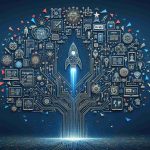The Dawn of a New Industrial Revolution: Robotics and AI at the Helm
Industrial automation is on the brink of a significant transition with the integration of AI into physical systems, poised to revolutionize sectors such as transportation, manufacturing, and logistics. While AI has already transformed digital workspaces, its expansion into physical AI systems in humanoids and factories marks a pivotal shift.
A trio of advanced computers is set to redefine this landscape by accelerating training, simulation, and reasoning processes, enabling unprecedented developments in industrial robotics. For decades, developments were confined to the scope of human-written serial code executed on general-purpose CPUs. However, the advent of breakthrough deep learning models, like AlexNet, on GPUs has ushered in a new era of AI-driven automation.
The Advent of Physical AI and the Autonomous Robot Era
As software evolves to write its own code, industries are witnessing an overhaul, shifting from traditional CPU-based computing to accelerated GPU computing. Despite these advancements, AI models still face challenges in comprehending the three-dimensional world – a gap physical AI aims to bridge. By leveraging generative AI, these systems can better perceive and interact with the physical world, preparing the groundwork for broader autonomy in robotics.
In the not-so-distant future, entities from hospitals to data centers will transition to autonomous, interactive systems powered by physical AI. Humanoid robots, specifically, are emerging as the quintessential form of universal robots, smoothly operating in human-tailored environments with minimal adjustment. The global market for these robots is anticipated to skyrocket, potentially reaching $38 billion by 2035.
Building the Future: From Simulation to Reality
NVIDIA’s ambitious initiatives in developing a suite of computers enhance the creation and deployment of physical AI, paving the way for revolutionary advancements in humanoid robot development. By combining cutting-edge simulation technology with powerful AI models, companies can refine robot capabilities within safe, virtual environments before real-world deployment.
With firms such as Boston Dynamics and Foxconn at the forefront, deploying self-operating teams alongside human workers, the industrial sector is edging closer to a digitally augmented future. Employing advanced software-in-the-loop testing, these enterprises can reduce deployment risks and associated costs.
The era of physical AI is upon us, setting the stage for transformative innovations across heavy industry and robotics. As these technologies continue to evolve, they promise to reshape the very fabric of industrial operations worldwide.
Innovative Tips and Life Hacks for Embracing AI and Robotics
As the dawn of the new industrial revolution begins to take hold, integrating robotics and AI into various sectors provides unique opportunities for both businesses and individuals. Whether you’re a professional in the industry or simply a tech enthusiast, adapting to these changes can be both exciting and challenging. Here are some tips, life hacks, and interesting facts to help you navigate this evolving landscape.
Understand the Basics of AI and Robotics
Before diving into advanced concepts, it’s essential to get a grasp of the fundamentals. Familiarize yourself with the principles of AI, including machine learning and deep learning, as well as basic robotics. There are numerous online resources available that can start you off on the right foot.
Embrace Continuous Learning
The field of AI and robotics is rapidly evolving. Stay updated by engaging in online courses, attending webinars, and following thought leaders in the industry. Websites like Coursera and Udacity offer courses designed to help you keep pace with advancements.
Get Hands-On Experience
One of the best ways to immerse yourself in this new era is by experimenting with robotics kits and software platforms. Platforms such as Arduino and Raspberry Pi provide excellent opportunities to build and program your own robots.
Collaboration is Key
In the workplace, encourage collaboration between human workers and AI-powered systems. Robots and AI can handle repetitive tasks, allowing humans to focus on more complex problem-solving. Promote interdisciplinary teamwork to maximize productivity and innovation.
Explore Generative AI Tools
Generative AI is reshaping industries by allowing machines to create new content, from art to music. Experiment with AI tools like DALL-E or GPT to understand how generative AI can complement creative tasks.
Interesting Fact: The Rise of Humanoids
Did you know that humanoid robots are designed to operate in environments built for human beings? This design choice facilitates smoother integration into existing settings without the need for significant changes. By 2035, the market for these versatile machines is expected to soar to $38 billion.
Invest in Simulation Tools
Simulation technologies are crucial in refining the capabilities of AI models and robots before their deployment in the real world. Companies like NVIDIA are at the forefront of developing powerful simulation tools that can help reduce deployment risks and costs.
Encourage Digital Literacy
For future generations, digital literacy is more important than ever. Encourage children and young adults to explore coding, robotics, and AI from a young age through interactive educational programs and resources.
Adopt a Sustainable Mindset
AI and robotics can significantly contribute to sustainable practices by optimizing resource use and minimizing waste. Embrace these technologies to enhance sustainability in your personal or professional projects.
As we continue to embark on this transformative journey into a new era of industrial operations, staying informed and proactive is key. By leveraging the potential of AI and robotics, individuals and businesses alike can not only adapt but thrive in this rapidly changing environment.


















